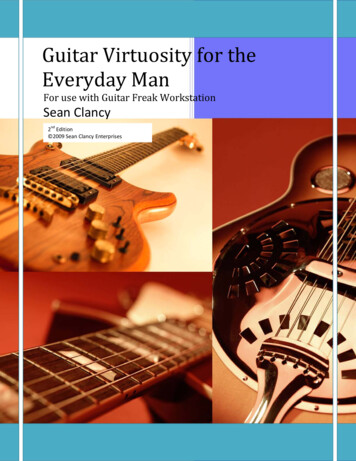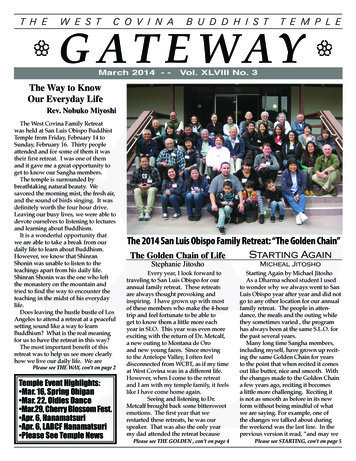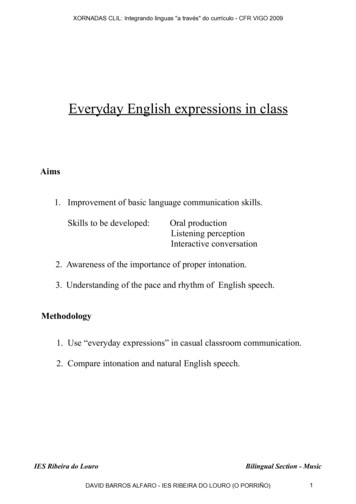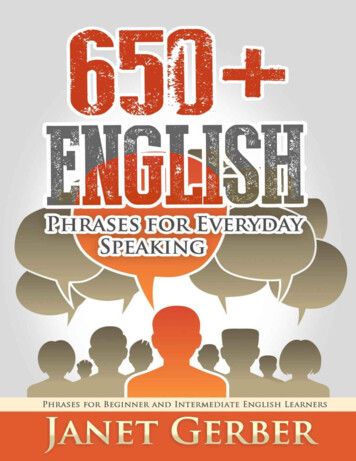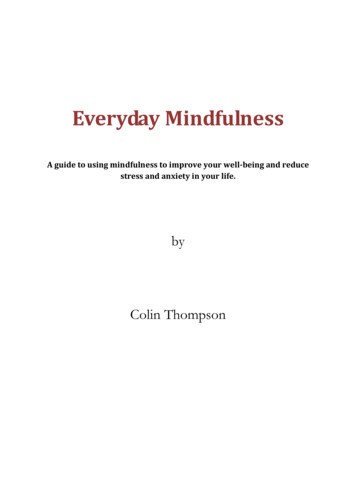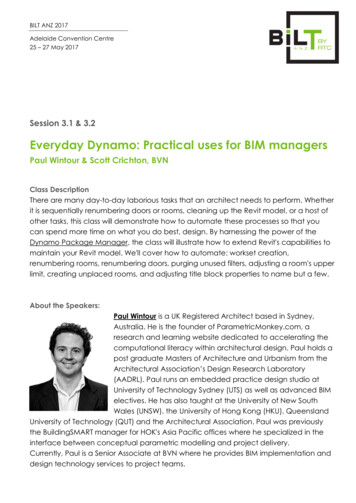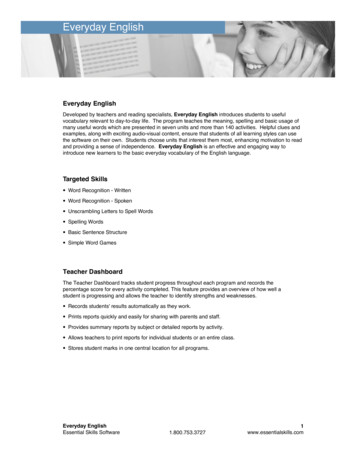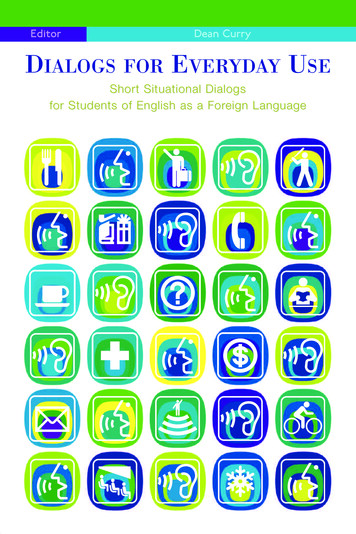
Transcription
Julia M. DobsonEditorDean CurryDIALOGS FOR EVERYDAY USEShort Situational Dialogsfor Students of English as a Foreign Language
"""J--"',I III
DIALOGS FOR EVERYDAY USEShort Situational Dialogsfor Students of English as a Foreign LanguageA NNEJ ULIA M. D OBSOND EAN C URRY, E DITORC OVELL N EWTON , L ANGUAGE N OTESUNITED STATES DEPARTMENTOFSTATEOffice of English Language Programsi
DIALOGSFOR EVERYDAY USEShort Situational Dialogs for Students of English as a Foreign LanguageJulia M. DobsonDean Curry, EditorLanguage Notes by Anne Covell NewtonFirst published in 1980Second printing 1994by the English Language Programs Divisionof the United States Information Agency,Washington, DC.This printing published in 2003by the Of fice of English Language Programsof the United States Department of State.Picture Credits: Page 2 Comstock/Trucking; Page 4 Comstock/Diversity Lifestyles; Page 7 Comstock/Business Teams; Page 2 Comstock/Trucking; Page 8 Comstock/Diversity Lifestyles;Page 10 Comstock/Diversity Lifestyles; Page 12 Photodisc/Education 2; Page 13 Photodisc/Education 2; Page 14 Comstock/Tele Connections; Page 18 Photodisc; Page 20 Photodisc;Page 22 Photodisc; Page 26 Photodisc; Page 28 Comstock/Diversity Lifestyles; Page 30 Photodisc/Education 2; Page 32 Photodisc/Business Today; Page 34 Eyewire/Wired for Busi ness; Page 40 Johanna Kowitz; Page 45 Photodisc; Page 46 Comstock/Pets & Vets; Page48 Photodisc/Business Today; Page 50 Comstock/Consumer Generation; Page 52 Photo disc; Page 53 left Photodisc/Festivities; Page 53 center EyeWire/Celebrations; Page 53 right Photodisc/Festivities; Page 54 Photodisc/Education. iiOffice of English Language ProgramsBureau of Educational and Cultural AffairsUnited States Department of StateWashington, DC ing/
112131415161718192021222324252627282930Formal Greetings and Farewells . . . . . . . . . . . 3Informal Greetings and Farewells . . . . . . . . . . 5Formal Introductions . . . . . . . . . . . . . . . . . . . . . 6Informal Introductions . . . . . . . . . . . . . . . . . . . . 9Time . . . . . . . . . . . . . . . . . . . . . . . . . . . . . . . . . . 11A Telephone Call . . . . . . . . . . . . . . . . . . . . . . . . 15Happiness . . . . . . . . . . . . . . . . . . . . . . . . . . . . . 17Ordering a Meal . . . . . . . . . . . . . . . . . . . . . . . . 19Birthdays . . . . . . . . . . . . . . . . . . . . . . . . . . . . . . 21A Crowded Theater . . . . . . . . . . . . . . . . . . . . . 23Mistakes . . . . . . . . . . . . . . . . . . . . . . . . . . . . . . . 24Games . . . . . . . . . . . . . . . . . . . . . . . . . . . . . . . . 25Health . . . . . . . . . . . . . . . . . . . . . . . . . . . . . . . . . 27Sports . . . . . . . . . . . . . . . . . . . . . . . . . . . . . . . . . 29Asking Directions . . . . . . . . . . . . . . . . . . . . . . . 31Coincidences . . . . . . . . . . . . . . . . . . . . . . . . . . . 33Safety . . . . . . . . . . . . . . . . . . . . . . . . . . . . . . . . . 35Musical Instruments . . . . . . . . . . . . . . . . . . . . . 37Taking a Vacation . . . . . . . . . . . . . . . . . . . . . . . 38Recipes . . . . . . . . . . . . . . . . . . . . . . . . . . . . . . . 39Weather . . . . . . . . . . . . . . . . . . . . . . . . . . . . . . . 41Having Things Done . . . . . . . . . . . . . . . . . . . . . 43Mailing Letters . . . . . . . . . . . . . . . . . . . . . . . . . 44Animals . . . . . . . . . . . . . . . . . . . . . . . . . . . . . . . 46Shopping . . . . . . . . . . . . . . . . . . . . . . . . . . . . . . 47Transportation . . . . . . . . . . . . . . . . . . . . . . . . . . 49Comparing . . . . . . . . . . . . . . . . . . . . . . . . . . . . . 51Pastimes . . . . . . . . . . . . . . . . . . . . . . . . . . . . . . 52Weddings . . . . . . . . . . . . . . . . . . . . . . . . . . . . . . 53Effort . . . . . . . . . . . . . . . . . . . . . . . . . . . . . . . . . 54iii
FOREWORD he 30 dialogs included in this booklet appeared originally inthe English Teaching Forum (Vol. 10, May–June 1972, No. 3)and are reprinted with very slight changes.Dialogs for Everyday Use are situation based, the emphasis beingon realism and naturalness to the extent that these are possiblewithin the limitations imposed by a short, self contained text.The speakers express themselves naturally in the way nativeAmerican speakers might speak in certain everyday situations.Speech is at normal speed and with “standard” pronunciationand intonation.The Language Notes provide information on grammar andintonation patterns, give cross references to similar patterns inother dialogs, and suggest additional examples that can be usedfor drills on the structure in question.An audiocassette is available with the booklet and is a necessarycomponent of the audio study unit.1
2
DIALOG 1Formal Greetings and FarewellsPaul: Hello. How are you?Don: Fine, thank you. How are you?Paul: Fine, thanks. (bus sound effect) Oh, excuse me—here’s mybus. Good bye.Don: Good bye.Language Notes Hello. Good morning or good afternoon might also be used.They are somewhat more formal. How are you? Notice the into nation. This how question is one of the few instances in which aform of BE receives the primary sentence stress. (This phenome non normally occurs in “question word” questions in which theform of BE stands at the end or is followed by a non demonstra tive pronoun: What IS it? Where IS he? When WAS it? Where willit BE? Where have you BEEN?) Sometimes, however, speakersstress the you, so that the intonation is identical to the “responsequestion” described below. How are you? Notice that the responding speaker uses a differ ent intonation for this question than the first speaker used. Theshift of stress onto you points to that word as carrying the new orchanged bit of meaning in this question, which is otherwise iden tical to the question in the first line—for now the you refers to adifferent person than it did in the original question. (Sometimesthe responding speaker will answer simply, “Fine, thank you—andyou?” omitting all the words of the “understood” question exceptthe one word you, which, uttered with a strong stress, carries thenew meaning. For an example, see Dialog 2.) Thanks is slightly less formal than thank you. Notice the contrac tion here’s ( here is).3
4
DIALOG 2Informal Greetings and FarewellsDick: Hi! How are you?Helen: Fine, thanks—and you?Dick: Just fine. Where are you going?Helen: To the library.Dick: O.K. I’ll see you later. So longHelen: So long.Language Notes Hi is an informal equivalent of hello. For the intonation of Howare you? see Dialog 1. Fine, thanks—and you? See Dialog 1. Notice the rising intona tion on and you? Notice that the normal response to Where are you going? issimply To the library—not I’m going to the library. It is unnat ural and unusual to repeat the information already supplied bythe question. O.K. is a less formal equivalent of all right. The common sayingI’ll see you later is often shortened to See you later (with the I’llunderstood). So long is an informal equivalent of good bye.5
DIALOG 3Formal IntroductionsMargaret:Mr. Wilson, I’d like you to meet Dr. Edward Smith.Mr. Wilson: How do you do, Dr. Smith.Dr. Smith:How do you do.Margaret:Dr. Smith is an economist. He’s just finished writing abook on international trade.Mr. Wilson: Oh? That’s my field, too. I work for the United Nations.Dr. Smith:In the Development Program, by any chance?Mr. Wilson: Yes. How did you guess?Dr. Smith:I’ve read your articles on technical assistance.They’re excellent.Language Notes6 Notice the rising intonation on the words Mr. Wilson. A fallingintonation on a name used in direct address is unusual in Ameri can English and tends to sound brusque and impolite. Listen forthe d in I’d. It is important to include the d in this expression inorder to differentiate it from I like, which has a different meaning.(I’d like I would like I want.) How do you do has the form of a question (and is sometimes fol lowed by a question mark), but it is not a question in meaning. Itis simply a polite formula used in formal introductions. The response to How do you do is simply the same phraseuttered with the same intonation by the other speaker. In fact,lines 2 and 3 are not strictly statement and response but ratherstatements uttered by the two speakers independently and,possibly, simultaneously. He’s just finished writing A useful pattern indicating an actionrecently completed. (Just is frequently used with the present per fect tense.) You may find it helpful to conduct a drill on this pat tern in conjunction with the teaching of the present perfect, usingvariations of this sentence, such as I’ve just finished reading ,I’ve just finished cleaning , She’s just finished correcting ,
They’ve just finished putting , The same pattern, with start orbegin, is commonly used for an action recently initiated: He’s juststarted writing , I’ve just started reading , She’s just startedcorrecting , etc. A somewhat simpler form of this pattern (just present perfect), to indicate an action recently completed, is of evenbroader usefulness: He’s just written , I’ve just read , We’vejust eaten , I’ve just heard , They’ve just returned , etc. Development program. Since these two words constitute a com pound noun, the principal stress falls on the first word. I’ve read Listen for the /v/ in I’ve. It is important to include the/v/ in this expression in order to differentiate it from I read, whichhas a different meaning. By any chance? possibly. Used in questions to confirm some thing you think might be true actually is.7
8
DIALOG 4Informal Introductions(Sound of background conversation)Jim:Who’s the tall girl next to Barbara?Charles: That’s Mary Anderson. Didn’t you meet her atSteve’s party?Jim:No, I wasn’t at Steve’s party.Charles: Oh! Then let me introduce you to her now. Mary,this is my cousin Jim.Mary:Hi, Jim. I’m glad to meet you.Jim:I’m glad to meet you. Can’t we sit down somewhereand talk?Mary:Sure, let’s sit over there.Language Notes Who’s is the contracted form of who is. It should not be con fused with the possessive whose, which, although pronouncedthe same (/huwz/), has a different meaning. Didn’t you meet her ? Notice the use of the negative question.While generally used to indicate the expectation of an affirmativeanswer, here it expresses surprise that the answer to the questionwill probably—and unexpectedly—be negative.Notice that in this sentence, the strongest stress, and the highpoint of the intonation, falls on at—although prepositions normal ly receive weak stress. It is as if at, in this case, were equivalentto present or there, as in I wasn’t present or I wasn’t there—inwhich the adjective and adverb, respectively, would normallyreceive the strongest sentence stress. Mary, this is my cousin Jim. Notice that the introducer mentionsthe girl’s name first, and introduces the young man to her (notvice versa). This is the normal, courteous manner of introductionamong speakers of American English. Notice the rising intonationon Mary, a name used in direct address. See note in Dialog 3. Hi. See note in Dialog 2.9
10 I’m glad to meet you. Notice that the second speaker says thissentence with a different intonation than the first speaker used.The second speaker emphasizes you. (Compare 1b. How areyou?) Can’t we sit down ? Would you like to sit down ? Sure is often used in informal conversation as a strong affirmativeresponse equivalent to yes, certainly, of course, etc.
DIALOG 5TimeMargaret: What time is it?Toni:It’s a quarter to five.Margaret: Aren’t we supposed to be at Jim’s house by five o’clock?Toni:Five or five thirty. He said it didn’t make any difference.Margaret: Then maybe we could pick your suit up at the cleaners.Toni:Sure, we have plenty of time.Language Notes It’s a quarter to five. This is probably the most common way ofstating this time. Other possibilities are It’s a quarter of five or It’sfifteen till five. (It’s four forty five is rarely heard in casual conver sation.) Fifteen minutes after the hour would usually be expressedthus: It’s a quarter after five or It’s a quarter past five. We alsohear It’s five fifteen (though this is less frequent in casual conver sation). An alternative form for five thirty is half past five. Fortimes other than the quarter hours or half hour, numbers areused: twenty past five or twenty after five, ten to five or ten tillfive, etc. Frequently the speaker will omit the It’s or It’s a andanswer simply A quarter to five or Quarter to five. Some speak ers omit or obscure the a: It’s (a) quarter to five. Aren’t we supposed to be ? Notice that the negative questionhere indicates, as it usually does, the speaker’s belief that his as sumption is true. He expects an affirmative response, a confirma tion of his assumption. Supposed to expected to; obliged to(not as strong as required to). This meaning of suppose occursonly in the passive. Other examples: I’m supposed to preparea program for our English Club meeting next week. They weresupposed to be here an hour ago—I don’t know where they canbe. We’re supposed to practice the dialogues at home, too. Chil dren are supposed to obey their parents. Notice the differencein intonation between the yes no question in line c (rising intona tion) and the wh question in line a (falling intonation). By fiveo’clock no later than five o’clock.11
12
DIALOG 1 He said it didn’t In conversation the conjunction that (He saidthat it didn’t ) is generally omitted in reported speech, as here.Notice the sequence of tenses: said didn’t. Where the verb indirect speech would be in the present tense (“Shall we com
English Teaching Forum (Vol. 10, May–June 1972, No. 3) andare reprinted with very slight changes. D ialogs for Everyday Use aresituation based,the emphasis being onrealism and naturalness to the extent that these are possible within the limitations imposed by a short, self contained text.File Size: 2MBPage Count: 61



